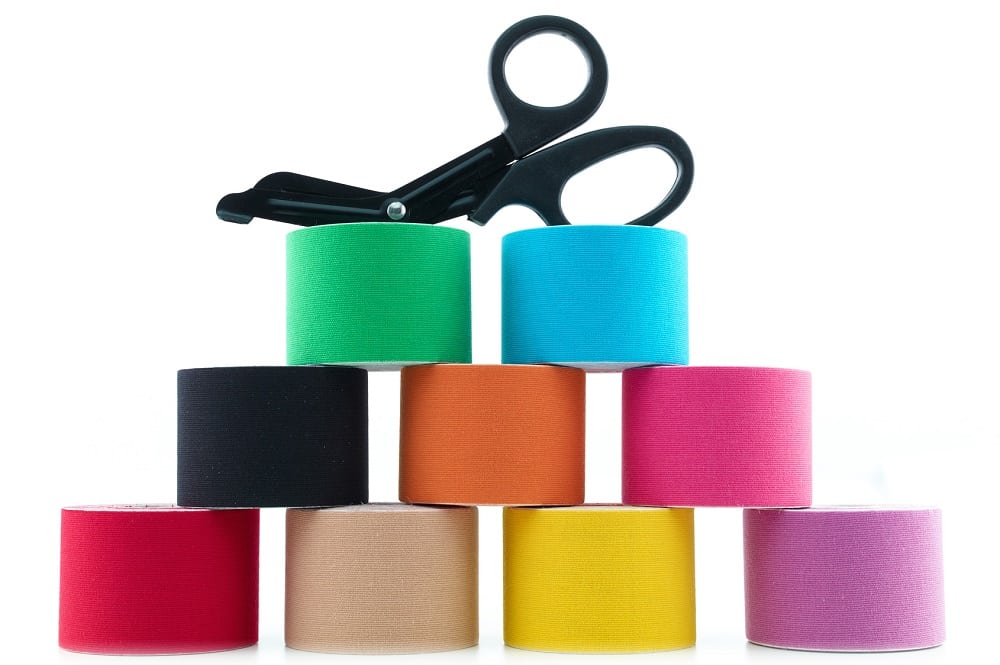Starting in one week, you’ll be seeing a lot of Kinesio tape worn by Olympic Athletes. Kinesio tape was first used in the 2012 London Summer Olympics by beach volleyball players, and Kinesio tape use has since taken off.
Kinesio tape, or KT tape, was originally developed in 1979 by Dr. Kenzo Kase, a Japanese chiropractor and acupuncturist. He created the tape because “
Starting in one week, you’ll be seeing a lot of Kinesio tape worn by Olympic Athletes. Kinesio tape was first used in the 2012 London Summer Olympics by beach volleyball players, and Kinesio tape use has since taken off.
Kinesio tape, or KT tape, was originally developed in 1979 by Dr. Kenzo Kase, a Japanese chiropractor and acupuncturist. He created the tape because “[h]e thought the standard taping methods of the time were too restrictive and may even extend injuries, because they inhibited the flow of inflammatory fluids beneath the skin.”1 Kinesio tape became publicly available in Tokyo in 1983, and was used in international competition by the All Japan National Volleyball Team in 1989.
By 1990, a method of muscle slacking using kinesio tape to relax muscles instead of support or stimulate them had been developed. The tape grew in popularity, and, by 1994, it was introduced in the rest of Asia and, soon after, in the US. In 1995, the Athletic Trainers Association received instruction in the taping method, and, by 1997, Kinesio tape was recognized by seven major baseball teams as an acceptable treatment. In 2001, Medicare created a reimbursement code for Kinesio tape treatment; the taping method’s recognition by a government healthcare program was major milestone.
KT tape use continued to grow through its introduction in the equine world as well as support for KT tape use during the 2008 Olympics in Beijing. Due to Kinesio tape use’s growth and expansion, we will be seeing it at the 2016 Rio Olympics, as well as in horse racing across the world.
So what does KT tape do? Kinesio tape is a flexible tape with waves in its adhesive which microscopically lift the skin. This lifting allows for more space between the tissue and the skin, which can become tight after an injury. Increasing space there can alleviate discomfort, facilitate lymphatic drainage, and allow for a decrease in inflammation, which reduces pressure and enables a more effective flow of blood and lymphatic fluid in and out of the target area.3
One interesting aspect of Kinesio tape is the lack of independent studies supporting the claims of KT tape proponents. A comprehensive literature review reveals that KT tape benefits are no different from the benefits of other taping methods. One study even suggests that the benefits may be a placebo effect of users’ knowing they’re wearing KT tape. Still, most patients treated with Kinesio tape do report a significant improvement from using it. They feel it relieves pressure and helps minimize pain.
To demonstrate the effectiveness of KT tape, I have included a picture of a significant bruise a patient developed after a fall. We applied KT tape to ease the discomfort and lift the tissue, speeding re-absorption of fluids.

As you can see, the areas that had been covered by tape are lighter and show less bruising. Also, the patient reported a decrease in pain after using KT tape for two days. So, although studies have not supported the theories of KT tape benefits, one can see from this picture how KT tape may work.
Kinesio tape is available at most drug stores, and there are instructional videos on YouTube demonstrating how to apply the tape. So, KT tape may be worth a try if you’re experiencing pain or tightness in a certain area (although KT tape should not replace consulting a physician or medical professional).
Works Cited
- Christensen, J. (2012, 8 10). cnn.com. Retrieved 7 19, 2016, from cnn: http://www.cnn.com/2012/08/10/health/olympics-kinesio-tape/
- Reynolds, G. (2015, 3 27). Ask Well. Retrieved 7 27, 2016, from New York Times: http://well.blogs.nytimes.com/2015/03/27/ask-well-does-kinesiology-tape-really-work/?_r=0
- www.kinesiotaping.com. (n.d.). Retrieved 7 28, 2016, from https://kinesiotaping.com/about/what-is-the-kinesio-taping-method/





